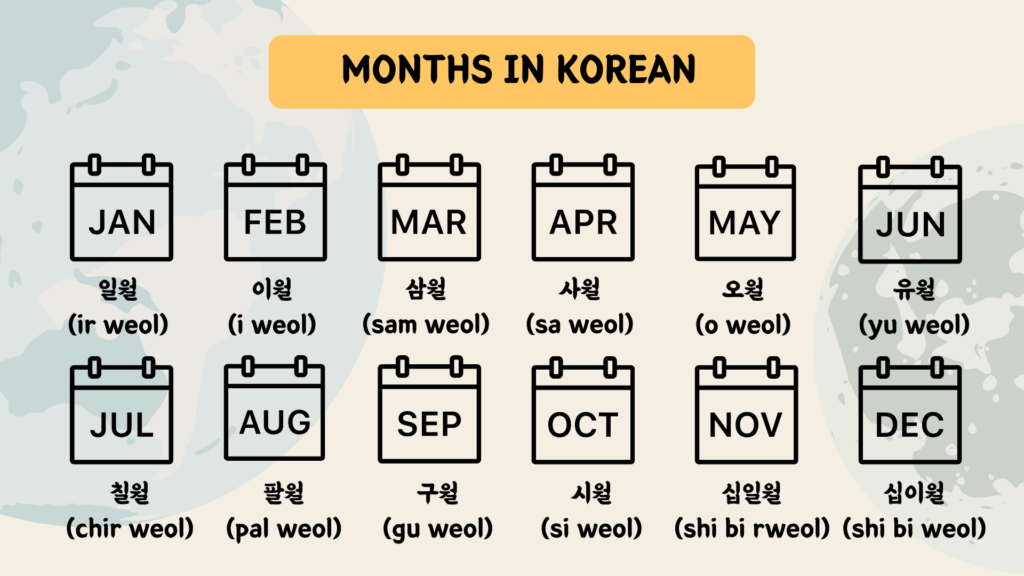
Welcome to our blog all about learning Korean language and culture! Today, we’re focusing on something practical: how to say the months in Korean. Whether you’re new to Korean or just curious, knowing the months in Korean can help you communicate better and understand Korean culture more. Let’s dive in and learn together.
In this blog, we’ll teach you how to say and write the different months in Korean. We’ll also show you how to write specific dates and years, like your birthday, which you can use in sentences. This will help you talk about things like your favorite holidays in South Korea, today’s date, and making plans with your Korean friends. You can combine this with lessons on telling time and learning the days of the week in Korean.
Below, we’ll give you a detailed guide on how to use these months. Let’s start learning the months of the year in Korean!
How To Say ‘Month’ in Korean
The word for “month” in Korean is “월 (weol)” or “달 (dal)“. The difference between “월 (weol)” and “달 (dal)” in Korean is subtle but important. Both words can mean “month”, but they are used in different contexts.
Example:
What month is this month?
– 이번달은 몇월이에요? [ibondareun myod worieyo]
월 (weol)
“월 (weol)” is indeed commonly used when discussing months in a general sense, as well as when referring to dates. It’s the go-to term for discussing months as units of time and for specifying dates in a straightforward, everyday manner. Whether you’re talking about a specific month or asking someone for the month, “월 (weol)” is the word you’ll frequently encounter in everyday conversations. For example:
- 일월 (ir weol) – January
- 이월 (i weol) – February
- 삼월 (sam weol) – March
달 (dal)
On the other hand, “달 (dal)” is often used when referring to the lunar month or in more poetic or literary contexts.
The word “달 (dal)” also specifically refers to the concept of a “month” as a unit of time, similar to how it’s used in English. So, when you want to talk about a month or months in general, you would use “달 (dal)” in Korean. For example:
- 한 달 (han dal) – One month
- 여섯 달 (yeoseot dal) – Six months
- 몇 달 (myeot dal) – How many months?
So, while both can mean “month”, “월 (weol)” is more commonly used in everyday language, while “달 (dal)” has a slightly more specific or artistic connotation.
List of Months in Korean

January
일월 (ir weol)

February
이월 (i weol)

March
삼월 (sam weol)

April
사월 (sa weol)

May
오월 (o weol)

June
유월 (yu weol)

July
칠월 (chir weol)

August
팔월 (pal weol)

September
구월 (gu weol)

October
시월 (si weol)

November
십일월 (shi bi rweol)

December
십이월 (shi bi weol)
In Korean, the months of June, October, November, and December have special names and pronunciations that differ slightly from the other months. Here are their names:
- June: 유월 (yuweol)
- October: 시월 (siweol)
- November: 십일월 (sibirweol)
- December: 십이월 (sibiweol)
It’s important to note these special names and pronunciations for these months, as they deviate from the pattern of simply adding numbers to “월 (weol)” for the other months. Understanding these special cases will help you accurately express dates and understand Korean calendars.
How to Express ‘Months of the year’ in Korean
January in Korean
My mom’s birthday is January: 우리 엄마의 생일은 일월이에요.
[uri ommae saengireun irworieyo]
February in Korean
February is usually cold: 이월은 보통 추워요.
[iworeun botong chuwoyo]
March in Korean
I went to Korea in March: 저는 삼월에 한국에 갔어요.
[joneun samwore hanguge gassoyo]
April in Korean
The weather gets warmer in April: 사월에는 날씨가 따뜻해져요.
[saworeneun nalssiga ttatteutaejoyo]
May in Korean
The season changes in May: 오월에는 계절이 바뀌어요.
[oworeneun gyejori bakkwioyo]
June in Korean
Summer begins in June: 유월에는 여름이 시작됩니다.
[yuworeneun yoreumi sijakttwemnida]
July in Korean
We go on a trip to the beach in July: 칠월에는 바다로 여행을 가요.
[chirworeneun badaro yohaengeul gayo]
August in Korean
Many people go on vacation in August: 팔월에는 휴가를 가는 사람들이 많아요.
[maneun saramdeuri parwore hyugareul ttonamnida]
September in Korean
I’ve been studying Korean since September last year: 작년 구월부터 한국어를 공부하고 있어요.
[jangnyon guwolbuto hangugoreul gongbuhago issoyo]
October in Korean
I want to go to Korea in October: 저는 시월에 한국에 가고 싶어요.
[joneun siwore hanguge gago sipoyo]
November in Korean
My birthday is November 1st: 제 생일은 십일월 일일입니다.
[je saengireun sibirwol iririmnida]
December in Korean
My sister was born in December: 내 여동생은 십이월에 태어났어요.
[nae yodongsaengeun sibiwore taeonassoyo]
How to Express ‘How Many Months‘ in Korean
When asking how many months, you can use “몇 개월” or “몇 개월이에요”. The difference is in politeness. Use “몇 개월이에요” when you want to be polite, like when talking to someone older or more respected. Use “몇 개월” with friends or people younger than you.
In Korean, you can express the number of months by using the formula:
- Sino-Korean number system
number + 개월 (number months)
Example:
2 months:
2 개월 = 이 개월 (i gae weol)
3 months:
3 개월 = 삼 개월 (sam gae weol)
4 months:
4 개월 = 사 개월 (sa gae weol)
…
2. Native Korean number
native Korean number + 달 (month)
한 달 (han dal)
두 달 (du dal)
세 달 (se dal)
Take note:
한달 (X) → 한 달 (O)
두달 (X) → 두 달 (O)
세달 (X) → 세 달 (O)
How to Write Dates in Korean
Writing dates in Korean follows a similar pattern to English, with the day followed by the month and then the year. Here’s how you would write a date in Korean:
[Year] 년 [Month] 월 [Day] 일
For example:
- 2023년 4월 24일 (April 24, 2023)
When writing shorter forms, you can omit the “년” (year) and “월” (month) if it’s obvious from the context. For example:
- 4월 24일 (April 24th)
- 24일 (the 24th)
Always remember to put the year first, followed by the month and then the day when writing dates in Korean.
Learning how to express months and dates in Korean is important for everyday communication and understanding Korean culture. Being able to talk about dates helps in making plans, discussing events, and sharing personal experiences. Whether you’re traveling to Korea or interacting with Korean speakers, mastering these skills adds depth to your language ability and fosters better connections with others. So, keep practicing and enjoy the journey of learning Korean!
Table of Contents

